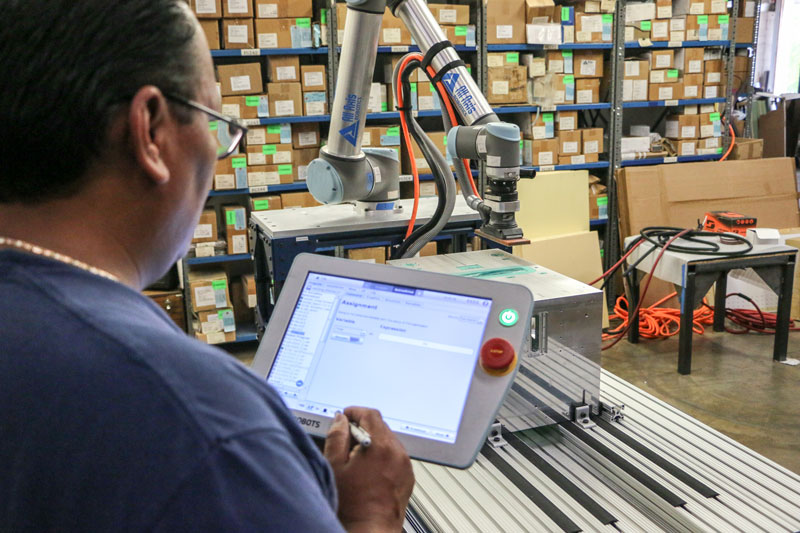The vehicle production industry has been among the quickest and most prominent adopters of robots for quite some time now. Vehicle production factories use mechanical robots for essentially all stages in the production line.
Today the car manufacturing industry is perhaps the most mechanized production line on the planet. Automobile manufacturers are constantly exploring the idea of using robots in many more tasks. This is because machines are more versatile, practical, precise, and reliable.
Vehicle assembling robots give car makers large economies of scale. They can enhance the volume and quality of parts produced, cut the overall cost of production and lessen production related constraints. These machines also protect laborers from tedious and strenuous tasks.
Car manufacturing companies typically use robots mainly for painting, welding, and pick and place tasks. Let’s take a look at why car makers deploy robots in their production lines and the roles these machines play in industries.
Why Do Car Manufacturers Deploy Robots in Their Production Lines?
Robots are Consistent
Car manufacturing industries aim to decrease variation in the quality of parts. Robots are ideal for this endeavor because of their high repeatability. In addition, these machines do not get tired or distracted, so all tasks are executed in the same way.
These machines also do not drop parts or grip so tightly that the part could break. Again, this lessens the quality issues faced when manual operators do most tasks.
Robots can be fitted with sight sensors that can detect substandard raw materials or fissures in parts made. This ensures that fewer blunders are made and that the manufacturer doesn’t need to replace parts returned by clients due to a malfunction
Robots Can Be Scale-Up to Meet Production Needs
Vehicle production lines operate with marginal stock levels to cushion against delays. This is why manufacturers are constantly searching for ways to ensure a steady flow in all phases of the production line.
With robots’ manufacturers are less worried about the steadiness of production levels. Robots do not suffer from exhaustion, and they can even be scale-up to meet additional production needs. This ensures manufacturers never disappoints their clients.
Robots Shield Laborers from Work-Related Injuries
There are numerous areas in a car production line that are unsafe for manual operators. At times the threats are apparent. Manual operators can suffer musculoskeletal issues because of heavy lifting and repetitive tasks.
For instance, laborers could experience harm from splatters caused by molten metal, coming into contact with fumes from paints and eyesores from light-emitting welding activities. Robots reduce injuries by taking up all these roles previously done by laborers.
Robots are Flexible
Indeed, robots are very versatile. These machines require short changeover periods from one task to another. A change in the end-effector is mostly all that’s required to enable a robot to handle new components.
In the future, some parts of the production line are likely to be obsolete. However, companies won’t be at a disadvantage because the machines previously used in these areas are flexible enough to be reconfigured and deployed in other areas.
The Roles of Robots in A Car Manufacturing Production Line Include:
Painting
Another role for robots in vehicle production lines that have been around for quite some time is painting. Back then, paint robots used hydraulics to function. Some of these hydraulic machines are still in use today, but they risk shoddy quality work.
Newer versions of painting machines are power-driven, and their precision enables them to paint parts more steadily. Many vehicle production lines deploy robots for painting tasks because they can easily paint inner parts that are otherwise hard to reach and not compromise quality. Also, robots can paint various exact designs on the vehicles.
Pick and Place Tasks
Pick and place tasks are perhaps the riskiest jobs in a production line allocated to manual operators. This is because the operators could trip as they move the parts or suffer wounds from the sharp edges. There is also a risk of spinal injuries from lifting very heavy parts.
Machines, on the other hand, are perfect for pick and place tasks. They can pick items from one side of the production line and place them in another without dropping them or causing any breakage. In addition, sharp edges cannot harm robots because they are inorganic.
Assembly Tasks
Assembly tasks in vehicle production include fitting electronic parts in the vehicle, mounting all the glass panes, and joining parts with bolts, among other things. All these tasks are suited to robots because they are very tedious and highly repetitive.
In many vehicle productions lines, you will find robots working on engines where they assemble all the pieces, resulting in a finished part. Engines have very delicate parts, and their assembly should be done with the utmost precision.
Welding
Gigantic robots with massive payload capacities and extensive reach can easily weld huge vehicle frame sheets. On the other hand, smaller machines can fuse smaller components such as brackets and mounts.
There are various kinds of welds that robots can do in car manufacturing industries, for instance, TIG arc welding, where the welding torch is placed in the same direction for all cycles, and the welds are repeated at very fast speeds. This ensures the ensuing weld is of high quality.
Robots can work alongside manual welders in massive vehicle production lines. The manual welders will, in most instances, countercheck the quality of the welds and raise an alarm in case of issues. They can also assist in aligning panels so that the machine can weld them together.
Quality Control
Robots can be fitted with sight sensors which are a critical element for quality control. These components can help flag items that do not meet the specific quality needs. This prevents defective parts from reaching consumers.
Sight sensors can be designed to identify inconsistencies in color, patterns, and edges. These sight sensors work quickly, which means they are ideal for vehicle production lines that involve a myriad of parts that should be created to meet the manufacturer’s standards.
Final Thought
All in all, there are a few limits with regard to tasks robots can perform in car making. It’s vital to recognize that these machines will be a mainstay in car industries for decades to come. Their maximum potential will only be realized once production lines are fully automated.

“Beer practitioner. Pop culture maven. Problem solver. Proud social media geek. Total coffee enthusiast. Hipster-friendly tv fan. Creator.”





